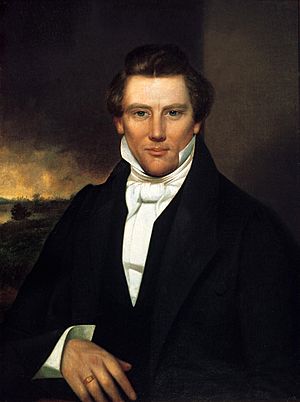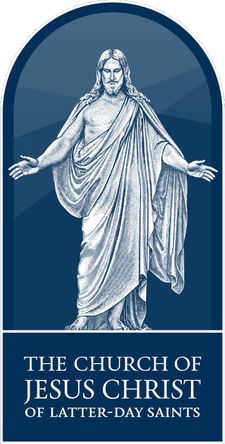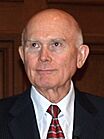President of the Church (LDS Church) facts for kids
Quick facts for kids President of The Church of Jesus Christ of Latter-day Saints |
|
|---|---|
| Style | President |
| Member of | First Presidency |
| Seat | Salt Lake City, Utah |
| Appointer | Quorum of the Twelve Apostles |
| Term length | Life tenure |
| First holder | Joseph Smith |
The President of the Church is the highest leader of The Church of Jesus Christ of Latter-day Saints. This important role was first held by Joseph Smith, who founded the church. The President leads the entire church and is also the head of the First Presidency, which is the church's top governing group.
Members of the church believe the President is a "prophet, seer, and revelator". This means they see him as a special messenger from God. They often call him "the Prophet," a title first given to Joseph Smith. When people talk about the President, they usually say "President" before his name. Russell M. Nelson served as President until his passing on September 27, 2025. The office is currently vacant. Dallin H. Oaks is the most senior apostle and is expected to become the next President.
Church members believe the President speaks for God to the whole world. He holds the highest spiritual authority on Earth. He is the only one who can receive guidance from God for the entire church or the world.
The President also leads other important church councils. These include the Council on the Disposition of the Tithes and the Council of the Church. He also serves as the chairman of the Church Boards of Trustees/Education, which oversees church schools and programs.
Contents
History of the Church President Role
How the Role Began with Joseph Smith

When the Church of Christ (now The Church of Jesus Christ of Latter-day Saints) was formed in 1830, Joseph Smith called himself "an apostle of Jesus Christ." However, other apostles and elders were also part of the church. This made the leadership structure a bit unclear at first.
In 1830, a special message to Joseph Smith clarified his unique role. It said that only he would receive important guidance and commandments for the church. This established him as the sole leader.
Later, in 1831, Joseph Smith and 22 other men were ordained as "high priests." This was a higher spiritual position than an elder. Still, it wasn't fully clear if Smith's role as an apostle gave him more authority than other high priests.
On November 11, 1831, another message to Smith explained that one high priest should lead all others. This leader would be called the "President of the high priesthood of the Church." This person would also "preside over the whole church." Joseph Smith was ordained to this position in January 1832.
In 1835, the church's rules were updated. Joseph Smith was then sometimes called the "First Elder" of the church. The updates also mentioned the "president of the high priesthood (or presiding elder)" as a key part of the church's leadership.
Who Leads Next? The Succession Question
In 1844, Joseph Smith died while in jail. His brother, Hyrum Smith, who was expected to be his successor, also died in the same event. Joseph Smith had not clearly stated who should lead the church next. This led to a time of uncertainty about who would become the new President.
Several people believed they should lead the church. Sidney Rigdon, a senior leader, thought no one could truly replace Joseph Smith. He suggested he should be a "Protector" of the church. However, Brigham Young disagreed. Joseph Smith had previously taught that the Quorum of the Twelve Apostles had "equal authority and power" to the First Presidency. So, Brigham Young argued that the Twelve Apostles should lead. Most people agreed, and Brigham Young was sustained as the leader of the Twelve Apostles. He then took charge of the church.
How Leadership Has Developed Over Time
On December 27, 1847, about three and a half years after Joseph Smith's death, Brigham Young was formally ordained as the President of the Church. At first, seniority (who was next in line) was based on when someone was first ordained as an apostle.
Over the years, the rules for seniority changed a few times to make sure the right person would lead. For example, in 1875, Brigham Young decided that seniority would be based on the longest continuous time someone had served as an apostle. This helped clarify who would become President next.
When a President passed away, the First Presidency (the top leadership group) would dissolve. The apostles who had been counselors would rejoin the Quorum of the Twelve. The most senior apostle in that Quorum would then become the new President. This system helped ensure a smooth transition of leadership.
In 1900, another important change happened. It was decided that seniority would be based on when someone became a member of the Quorum of the Twelve, not just when they were ordained an apostle. This helped make the line of succession even clearer.
Since 1918, if the President of the Quorum of the Twelve is called to be a counselor in the First Presidency, another senior apostle is appointed as the "Acting President" of the Quorum. This ensures that the Quorum always has a clear leader.
The President of The Church of Jesus Christ of Latter-day Saints
Current Status of the Presidency
Russell M. Nelson served as the 17th President of the church. He was ordained on January 14, 2018. President Nelson passed away on September 27, 2025.
Following President Nelson's passing, the office of President is currently vacant. The church will soon follow its established process to select and set apart a new President.
How a New President is Chosen
When a President of the church passes away, the First Presidency (the top leadership group) is dissolved. The members of the First Presidency who were also part of the Quorum of the Twelve Apostles return to that Quorum. The Quorum of the Twelve then becomes the main governing body of the church.
The most senior apostle in the Quorum of the Twelve becomes its president. Seniority is based on how long someone has been a member of the Quorum, not their age. By a long-standing tradition, this senior apostle always becomes the next President of the Church.
The official appointment happens when the Quorum of the Twelve meets to choose and set apart the new President. This usually happens quickly, often within days or weeks of the previous President's passing.
After the new President is chosen, church members have a chance to show their support for him. This happens at the next general conference during a special meeting called a "solemn assembly".
Understanding Seniority in the Quorum of the Twelve Apostles
Seniority in the Quorum of the Twelve Apostles is very important. The most senior apostle leads the Quorum and is expected to become the next President of the church.
Special rules have been made for unusual situations. For example, if an apostle was temporarily removed from the Quorum and later returned, they would lose their previous seniority. Their seniority would then be based on when they rejoined the Quorum.
In 1900, a clear rule was established. Seniority is determined by the date an individual became a member of the Quorum of the Twelve. It is not based on the date they were first ordained as an apostle. This rule helps ensure a clear and consistent line of succession.
Sometimes, the President of the Quorum of the Twelve is asked to serve as a counselor in the First Presidency. In this case, the next most senior apostle who is not in the First Presidency is appointed as the "Acting President" of the Quorum. This ensures the Quorum always has a leader.
Guidance and Teachings from the President
When the President of the church speaks in his official role, his words are seen as important guidance. However, church members are taught not to follow anyone "blindly." They are encouraged to compare statements with what is found in church scriptures. If something contradicts scripture, members should question it.
Because Latter-day Saints believe in "continuing revelation" (God still gives guidance today), instructions from a President can be updated or clarified by a future President. It's accepted that leaders might revise past teachings. Church leader Ezra Taft Benson taught that we should "beware of those who would pit the dead prophets against the living prophets, for the living prophets always take precedence." This means the current leader's guidance is most important.
Not everything a President says is considered official church teaching (doctrine). Joseph Smith taught that "a prophet is a prophet only when he was acting as such." When a President declares new doctrine, he will state it as guidance from God. This new doctrine must also be accepted by the Quorum of the Twelve and supported by the church members. If it's not accepted as God's word, members are not required to follow it.
Even in formal church meetings, the President might sometimes say he is sharing a personal opinion. However, church members often feel a strong desire to follow suggestions from the President, whether they are official doctrine or personal counsel.
Church Presidents have taught that God will never allow the President to lead the church astray. They believe God will "remove" any leader who intends to mislead members. This doesn't mean leaders are "infallible" (never make mistakes). Instead, it means their mistakes won't cause lasting harm to the church's work. So, the current President can clarify, correct, or change previous teachings.
Counselors Who Help the President
First Presidency prior to its dissolution
First Counselor
Second Counselor
When a new President of the church is chosen, he selects counselors to help him. Most Presidents have at least two counselors. Sometimes, there have been more, like when David O. McKay had five counselors.
Counselors are usually chosen from the members of the Quorum of the Twelve Apostles. However, sometimes people from other church leadership roles or even from the general church membership have been called. Any worthy high priest in the church can be chosen as a counselor.
Counselors are given titles like "First Counselor" and "Second Counselor" based on when the President selected them. The President and all his counselors together form the First Presidency. This is the highest leadership group in the church. The next most senior apostle after the President is appointed as the President of the Quorum of the Twelve Apostles.
How a President Could Be Removed
While it has never happened, a President could theoretically be removed or disciplined by a group called the Common Council of the Church. The only President to appear before this Council was Joseph Smith. He faced charges of misbehavior in 1834. The Council found that Joseph Smith had acted honorably and properly with all the money and property he was in charge of.
See also
- Assistant President of the Church
- We Thank Thee, O God, for a Prophet




